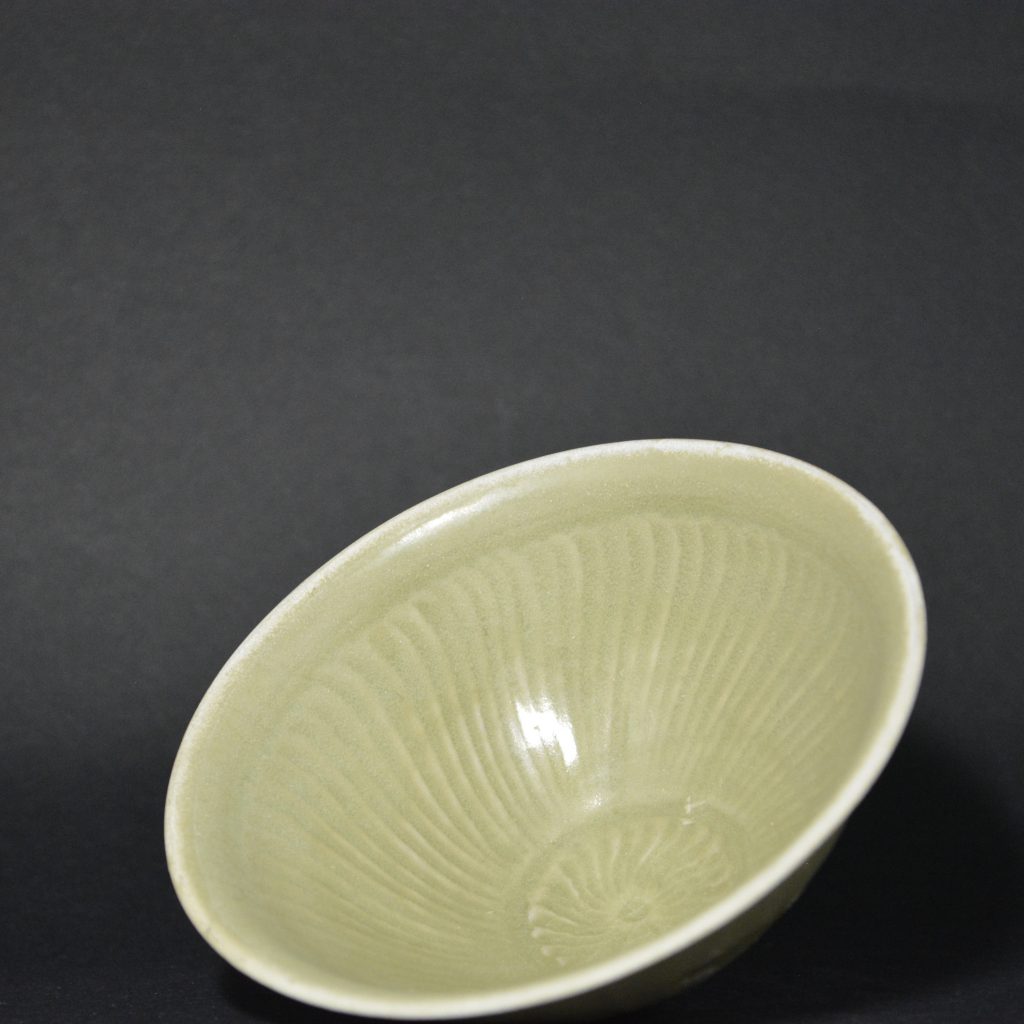
A Song or Jin Yaozhou Celadon Ware Bowl c.12th Century.
A small Yaozhou Celadon bowl from the Yaozhou kilns in Shaanxi or Henan Province, Northern Song (960 – 1127) or Jin dynasty (1115 – 1234). The conical shaped celadon bowl is moulded with two separate registers of over-lapping ogee lines. The exterior to this celadon bowl is cut with vertically forming a rhythm of lines that surround the bowl. The glaze is dry in a few areas above the foot.
SOLD
- Condition
- In good condition, this yaozhou bowl has areas where the glaze is rather dry, the rim and around the foot. If the bowl is tapped while on a flat surface it wobbles slightly.
- Size
- Diameter : 10.8 cm (4 1/4 inches). Height : 4.5 cm (1 2/3 inches).
- Provenance
- A Private Collection of Early Chinese Ceramics.
- Stock number
- 24955
- References
- For a similar Song Yaozhou stoneware bowl See : Sung Ceramic Designs (Jan Wirgin, Han-Shan Tang Ltd, 1979, ISBN 0-906610-01) Plate 4 Item d.
Information
Yaozhou Celadon :
Yaozhou Celadon ware comes in many forms, but small crisply moulded or carved bowls were a popular product, as were miniature press-moulded figures or animals, toys and everyday utensils. The Yaozhou kilns main production at Shaanxi was celadon, but they also produced black and brown wares as well.
Song Yaozhou glazes are rather different to both earlier and later Chinese Celadons. Later celadons from Longquan of the Yuan and Ming Dynasties have a very thick rich glaze suffused with bubbles throughout, these diffuse the light hitting the glaze, creating a very soft rich sheen. Yaozhou Celadons have a thinner glaze with smaller bubbles. Yaozhou celadons have a more obvious green than earlier wares but the thinness of the glaze means that the ceramic body is far more likely to be visible than on Longquan celadons. The colour of Yaozhou celadons tends to be more to wards olive green rather than the Longquan celadon which is normally richer and nearer a true green.
Celadon Ware :
Celadon is a term used to describe several types of Chinese stoneware and porcelain, as well a ceramics from other countries, notably from Korea and Japan. The term is a imprecise one, applying to various types of green glazed ceramics, but not all ceramics with green glazes, there are several wares that have a green glaze that are not refereed to as celadon. For example Green Jun and Ge Ware. For this reason there has been a move to try to clarify the situation by using the term `Green Ware`. But for now Celadon is a more familiar and therefore useful term. The origins of the term Celadon are not clear, one theory is that the term first appeared in France in the 17th century and that it is named after the shepherd Celadon in Honoré d`Urfé`s French pastoral romance, L`Astrée (1627), who wore pale green ribbons. (D`Urfe, in turn, borrowed his character from Ovid`s Metamorphoses.) Another theory is that the term is a corruption of the name of Saladin, the Ayyubid Sultan, who in 1171 sent forty pieces of the ceramic to Nur ad-Din, Sultan of Syria. Yet a third theory is that the word derives from the Sanskrit sila and dhara, which mean “stone” and “green” respectively. Celadon ware originated in Zhejiang Province in the Eastern Han Dynasty, however green monochrome glazes can be found on stoneware much before that date. Zhejiang is were the famous Longquan Celadons were made but Celadon wares were also produced at Jiangsu, Hubei, Hunan and Jiangxi. The production of Celadon Ware required a reducing atmosphere of around 1300 degrees C., the colouring agent was a mixture of iron oxide and titanium. The glaze was applied very thickly, and was full of tiny bubbles which defuse the light giving the appearance of richness and softness.








